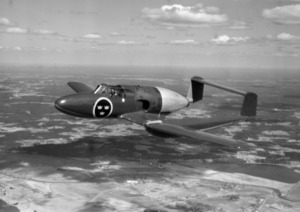
The de Havilland DH.103 Hornet, developed by de Havilland, was a fighter aircraft driven by two piston engines. It further exploited the wooden construction techniques that had been pioneered by the de Havilland Mosquito. Development of the Hornet had started during the Second World War as a private venture. The aircraft was to conduct long range fighter operations in the Pacific Theatre against the Empire of Japan but the war ended before the Hornet reached operational squadron status.
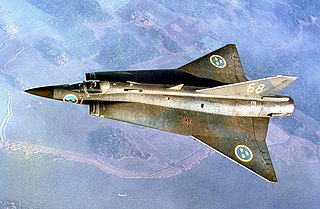
The Saab 35 Draken is a Swedish fighter-interceptor developed and manufactured by Svenska Aeroplan Aktiebolaget (SAAB) between 1955 and 1974. Development of the Saab 35 Draken started in 1948 as the Swedish air force future replacement for the then also in development Saab 29 Tunnan dayfighter and Saab 32B Lansen night fighter. It featured an innovative but unproven double delta wing, which led to the creation of a sub-scale test aircraft, the Saab 210, which was produced and flown to test this previously-unexplored aerodynamic feature. The full-scale production version entered service with frontline squadrons of the Swedish Air Force on 8 March 1960. It was produced in several variants and types, most commonly as a fighter-interceptor.

The de Havilland Vampire is a British jet fighter which was developed and manufactured by the de Havilland Aircraft Company. It was the second jet fighter to be operated by the RAF, after the Gloster Meteor, and the first to be powered by a single jet engine.
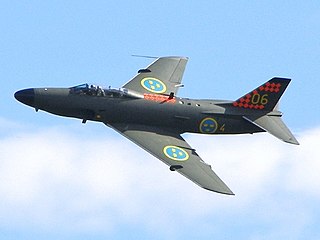
The Saab 32 Lansen is a two-seat, transonic military aircraft designed and manufactured by the Swedish aircraft manufacturer Saab AB.

The de Havilland DH 112 Venom is a British post-war single-engined jet aircraft developed and manufactured by the de Havilland Aircraft Company. Much of its design was derived from the de Havilland Vampire, the firm's first jet-powered combat aircraft; it was initially referred to as the Vampire FB 8 prior to the adoption of the Venom name.

The Saab 91 Safir is a three or four seater, single engine trainer aircraft. The Safir was built by Saab AB in Linköping, Sweden and by De Schelde in Dordrecht, Netherlands.

Volvo Aero was a Swedish aircraft, guided missiles and rocket engine manufacturer. It became GKN Aerospace Engine Systems following the company's acquisition by British engineering conglomerate GKN during 2012.

The Saab 29 Tunnan, colloquially also Flygande Tunnan, is an early jet-powered fighter aircraft designed and produced by the Swedish aircraft manufacturer Saab. It was the second turbojet-powered combat aircraft to be developed in Sweden, the first being the Saab 21R, and it was the first Western European fighter to be produced with a swept wing after the Second World War, only being preceded in Western Europe as a whole by the Messerschmitt Me 262 built during the conflict.

The Saab 105 is a Swedish high-wing, twinjet trainer aircraft developed in the early 1960s as a private venture by Saab AB. The Swedish Air Force, which had opted to procure the type for various roles, issued the aircraft with the designation Sk 60. The Sk 60 entered service in 1967, replacing the ageing De Havilland Vampire fleet.

The de Havilland Ghost was the de Havilland Engine Company's second design of a turbojet engine to enter production and the world's first gas turbine engine to enter airline service. The Ghost powered the de Havilland Venom, de Havilland Comet and SAAB 29 Tunnan. It was a scaled-up development of the Goblin.
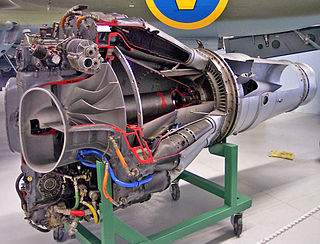
The de Havilland Goblin, originally designated as the Halford H-1, is an early turbojet engine designed by Frank Halford and built by de Havilland. The Goblin was the second British jet engine to fly, after Whittle's Power Jets W.1, and the first to pass a type test and receive a type certificate issued for an aircraft propulsion turbine.

The RP-3 was a British air to ground rocket projectile introduced during the Second World War. The "3 inch" designation referred to the nominal diameter of the rocket motor tube. The use of a 60 lb (27 kg) warhead gave rise to the alternative name of the "60-pound rocket". Though an air-to-ground weapon, it saw limited use in other roles. They were generally used by British fighter-bomber aircraft against targets such as tanks, trains, motor transport and buildings, as well as by Coastal Command and Royal Navy aircraft against U-boats and ships.

The Saab 18 was a twin-engine bomber and reconnaissance aircraft, designed and built by Svenska Aeroplan AB (SAAB) for use by the Swedish Air Force in response to a 1938 design competition. Due to delays, it did not enter service until 1944, but quickly became the standard Swedish bomber aircraft. Serving in the bomber, reconnaissance and ground-attack roles, it also assisted in the development of ejection seats and air-to-surface guided missiles until its replacement by the Saab Lansen in the late 1950s.

The SAAB 21 is a Swedish single-seat low-wing monoplane fighter and attack aircraft designed and manufactured by SAAB. It used a relatively unorthodox twin boom fuselage with a pusher engine, giving the aircraft an unusual appearance.

The Malmö Flygindustri MFI-9 Junior was a light aircraft produced in Sweden in the 1960s. The aircraft was also produced under licence in West Germany as the Bölkow Bo 208.

The Focke-Wulf Flitzer was a jet fighter under development in Germany at the end of World War II.

The Fiat G.80 was a military jet trainer designed and produced by the Italian aircraft manufacturer Fiat. It has the distinction of being the first true jet-powered indigenous aircraft to be flown by Italy.

The North American FJ-1 Fury is an early turbojet-powered carrier-capable fighter aircraft used by the United States Navy (USN). Developed by North American Aviation (NAA) starting in 1945, it became the first jet aircraft in USN service to serve at sea under operational conditions. This first version of the FJ was a straight-winged jet, briefly operational during the transition to more successful designs. An evolution of the FJ-1 would become the land-based XP-86 prototype of the United States Air Force's enormously influential F-86 Sabre, which in turn formed the basis for the Navy's carrier-based, swept-winged North American FJ-2/-3 Fury.
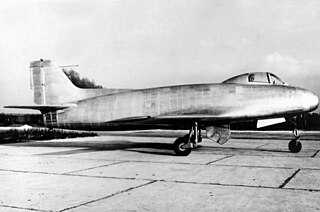
The Nord 2200 was a French carrier-based, jet-engined interceptor developed in the late 1940s. It was intended to compete for an Aéronavale contract, but was not selected for production after a 1950 accident badly damaged the sole prototype. It was repaired and resumed flight testing the following year, which including evaluating rocket-assisted take offs. After the aircraft made its last flight in 1954, it was used as a gunnery target. Much of the airframe was recovered in the 1980s, but its current disposition is uncertain.
